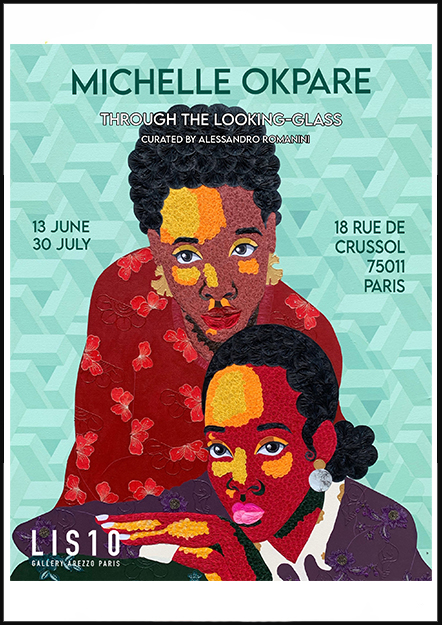
Michelle Okpare (1996), who despite her young age already boasts a distinguished exhibition curriculum that has seen her works exhibited in the recent past in public and private spaces from Los Angeles to Cape Town, from Arezzo to Lagos, from St. Petersburg to Paris, and can boast a qualified presence in international collections, has created a series of paintings and sculptures specifically for the Paris space of the Italian gallery, as the artist herself emphasizes, "An event that I strongly wanted to take stock of my expressive and individual evolution, in a particular historical and personal conjuncture."
The title - with reference to Lewis Carroll's famous 1871 work - which alludes to the iconographic and literary valences of the mirror, including that of personal investigation, identity and as a bridge between real vision and the mirror image but also as an opening to other, further realities, which multiply, generating in the observer an infinite series of possible narratives and interpretations.
Michelle Okpare who lives and works in Lagos, a megalopolis in constant evolution-as the Dutch architect-urbanist Rem Khoolas already pointed out-in which, from her studio she continues to animate a privileged observatory to document at the same time the surrounding reality and delineate a representation (pictorial and sculptural) of herself freed from the Eurocentric dimension and by extension of the African woman in the context of contemporary society, obviously involving reflections related to gender and black beauty.
As the artist further illustrates, "I use poor, recycled, salvaged, ready-to-use materials related to the experiences of my childhood spent in Côte d'Ivoire, materials that have finished the functional cycle of the society of hyper-production, which carry with them a material memory of the users and the producer artisans (in most cases women), to which I love to give back life in an aesthetic context, which is also a tool of reflection for me and the observer."
Crepe paper shaped into floral and petal motifs, torn lace or torn shreds of clothing, brightly colored, with which she also articulates a complex color pattern with references to those nonverbal languages related to ethnicity, outlining, in most cases, self-portraits.
Although his image is always the fulcrum and support of the artistic process, his is not a militant will but firmly oriented to weld the millenary cultural and identity roots of a country like Nigeria with the iconographic and cultural instances of a globalization that spares no continent and that diaspora, emigration and nomadism nurture.
Yet another stage the one hosted by LIS10 Gallery in Paris, of its own original and inexhaustible research journey, particularly significant because it was made in a period marked by war events, ethnic and political clashes, cancel cultures and struggles for gender rights still violated.